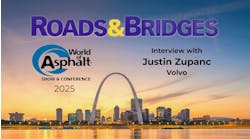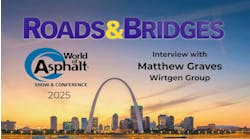By: Lee Geistlinger
Maryland, like most other states, has certain intersections that are prone to rutting. The reasons may differ from one intersection to another-one may have heavy truck traffic; another may be located at the base of a hill-but the result is always the same: Rutted roads that slow traffic and require frequent repair or repaving. In 1994, the Maryland State Highway Authority (SHA) decided to try to find a solution to this problem with a "head to head" competition that would allow paving-industry interests to do whatever they thought best to try to remedy the situation.
The premise was simple: Identify two similar intersections with comparable degrees of rutting; establish
a reconditioning budget that was the same for both projects; assign one
project to the asphalt industry and one to the portland cement concrete
industry and let each come up with its own "best" solution to
the problem. These test projects would, in essence, allow each industry
to put its best foot forward and, at the same time, give the SHA possible
solutions for future work. The SHA contacted representatives from each industry
and found them agreeable to such a plan.
The asphalt industry established a small task force to address the situation.
The task force consisted of the Maryland Asphalt Association, Glen Burnie,
and its members; the National Asphalt Pavement Association, Lanham, Md.;
and the Asphalt Institute, Lexington, Ky. Ron Corun, vice president of T.C.
Simons Inc., Fallston, Md., was on the committee; Simons also was the contractor
for the asphalt-industry's intersection. "There was a budget for the
program, but no parameters," Corun says. "While we discussed other
options, we pretty quickly came to the conclusion that a Superpave mix would
be our best bet, considering the traffic the intersection received."
The intersection the asphalt industry received was the junction of U.S.
Route 40 (east-west) and Maryland State Route 213 (north-south), which is
located in Cecil County, at the northern end of the Chesapeake Bay. With
an ADT of 29,200 on the former road and 13,900 on the latter, the intersection
had experienced rutting of approximately 1 in. per year. Especially on Route
40-which is a main trucking route (12% of traffic is trucks)-the slow-moving,
heavy load would put whatever pavement was placed to the test.
The heavy traffic also presented another challenge: It was important to
keep the road open as much as possible during the renovation. In order to
best accommodate the traffic, the decision was made to work at night-from
7 p.m. through 6 a.m., Sunday through Thursday.
"We're the third link," comments Corun on the decision to use
Superpave for the test. "The other two are the government researchers
and the DOTs. And we're the ones who actually have to go out there and put
this stuff down." While Corun says he was a bit apprehensive about
using the new mix design on such an important test, he felt confident with
the selection, given Superpave's test-proven ability to resist the rutting
that had long plagued this section of roadway.
Core samples indicated an 8-in.-thick hot-mix asphalt layer over a 9-in.-thick
jointed portland cement concrete base. Measurements indicated rutting of
over 1.5 in. To fill in the unknowns, Simons made a 1-ft-wide cut into the
travel lane on Route 40. Based on the condition of the cores and cuts, the
decision was made to mill off the full 8 in. of asphalt and replace it with
the same thickness, so as to tie back into the existing commercial driveways
along the roadway.
There was some debate over how to replace the hot-mix: one suggestion was
to replace the entire course with three lifts of the same material. However,
a two-mix design was settled upon, with the base mix having a larger maximum
aggregate than the surface coat.
Since the Superpave weather station database included a location in nearby
Elkton, at 98% reliability the guidelines called for a modifier of PG 64-22.
After correcting for the slow-moving traffic that was endemic to the area,
a final selection of PG 76-22 was made.
At the same time, it was decided to use the same grade of asphalt cement
for the entire 8 in. Corun says this latter decision would have been a more
difficult call if this had been a large project, but, for the relatively
small amount of HMA going down (approximately 5,000 tons), the extra cost
was well worth it for the additional safety margin.
Limits of the reconditioning were set by the industry and the SHA (figure,
below); only the eastbound travel and passing lane will be compared to the
same in the portland cement concrete industry's intersection, so the comparison
will be an equitable one.
The design mix was done by engineers and technicians at the Asphalt Institute.
The asphalt content of the base coat was 4.6%; the asphalt content of the
surface coat-after much discussion and several trial patches in Simons'
parking lot-was established at 4.9%. Although the surface-coat design called
for a 4.7% asphalt content, the 4.9% mix met all of the Strategic Highway
Research Program's (SHRP) criteria, and it was 0.3% higher than the base
mix. The 0.1% difference between the base and surface coats' asphalt contents
had been a concern to committee members.
With the mix decided on and Simons' crews having gotten familiar with the
mix during the parking lot tests, it was time to begin work on the project
itself.
Work commenced the night of Monday, Aug. 15, 1994 and was completed just
over two weeks later on August 30. Work included milling the existing hot-mix
asphalt, placing up to 8 in. of Superpave mix and remarking the road with
traffic lines.
As planned, all work took place at night, something Simons is not unfamiliar
with. Even though the road is heavily traveled, traffic drops off considerably
after 11 p.m., decreasing the safety risk for workers and minimizing delays
for motorists. Both the milling and paving schedules were planned to make
all lanes available when work was not in progress; this goal was met.
The amount of HMA put down varied with the section of the road and how much
HMA had been milled off: All surface coats were 2 in. thick; the base coats
were either 3 in. (one lift) or 6 in. (two lifts of 3 in. each) thick. Nightly
quality control tests were conducted by Simons to evaluate asphalt content,
gradation, volumetrics (Marshall) and in-place air voids.
To help adhere to SHRP guidelines, samples also were lifted each night and
taken to Koch Materials Laboratory, Pennsauken, N.J., (approximately 2 hours
from the site) for gyratory compaction.
According to Corun, the paving was just "business as usual" for
the crew, even though the Superpave mixes were a new material for the company.
While there was a hint of segregation in the base mix where the kickback
paddles tried to work the material back into the center of the pave, the
surface coat went down very uniformly, better than many mixes containing
aggregate of similar size and low asphalt content. There was no indication
of end-of-load segregation sometimes observed on low-asphalt-content mixes.
"One problem that we did have, however," Corun says, "was
that a turning lane we milled the asphalt off of turned out to have dirt
underneath it. We hadn't cored this section, so it was a surprise." Crew members dug out the section and put down a base.
Beyond this one hitch, however, the work progressed according to plan. Traffic
delays were minimal, no complaints were received from the motoring public
and the project actually finished slightly ahead of schedule.
The bottom line is always a concern in paving projects, especially one that
puts one industry head-to-head with another. However, Corun says the Superpave
mix, although more expensive than conventional HMA, still is a bargain compared
to portland cement concrete. "We calculated costs for the project that
factored in user delays," he says, "and it came out to $36.11
sq/yd. For a 30-year life-cycle cost, the figure rises to $58.94 sq/yd.
The portland cement concrete, on the other hand, cost $104.25 sq/yd, and
that does not include the user delay. Overall, we are very pleased with
the results of this mix."
Last summer-approximately one year after project completion-Simons went
over the area to see how it was holding up. Cecil County set a record last
year for consecutive days over 90 deg, but, despite this heat stress, Corun
says tests indicated virtually no rutting. Smoothness tests conducted in
September gave very favorable results.
In a report to the Maryland SHA, the asphalt industry spelled out its conclusions and recommendations concerning the U.S. Route 40 and Maryland State Route 213 rehabilitation project, which include the following:
- Include every aspect of the industry on the committee: contractors, material suppliers and associations.
- Forensic analysis is necessary. You can never have too much information. Pavement analysis should include existing-pavement thickness, mix properties and depth of rutting within the mix.
- Test sections should be built before the project to enable plant, paving and compaction crews to feel comfortable with the SHRP mixture.
- Hot-mix offers the ability to rehabilitate an intersection with the least disruption to the motoring public, especially if the work takes place during nonpeak traffic hours.
- SHRP mixtures offer routine plant and paving procedures, producing mixtures that increase rut resistance and pavement durability.
Cost is a factor. However, as John Bellizzi, Des Moines Public Works director,
points out, Superpave mixes are just another paving tool (sidebar, page
31). Used improperly, it will cost more than it is worth. Used properly-such
as in this Maryland intersection where the ADT is high and rutting a perpetual
problem-the slightly more expensive Superpave mixes will more than pay for
themselves.
In addition, as the asphalt industry's report to the Maryland SHA points
out, as SHRP mixes become more commonplace, the price for them should decrease.
While the materials (in particular, modifiers) in the Superpave mixes can
make them more expensive than conventional mixes, there is currently a "learning
curve" for the contractors using Superpave mixes. This leads to additional
costs. As contractors become more at home with the SHRP products, these
particular costs will practically disappear.
As with any paving job, only time can truly measure the worth of the project. How "Super" is Superpave? The project appears a success today; a few more years of heavy traffic will help confirm or dispel that conclusion.


